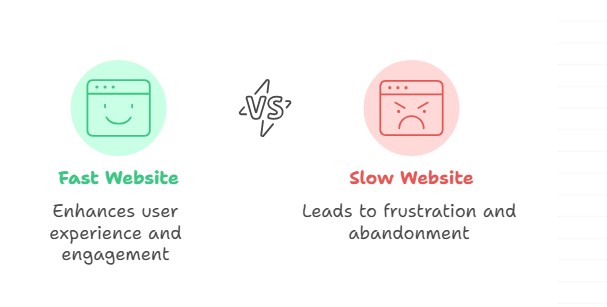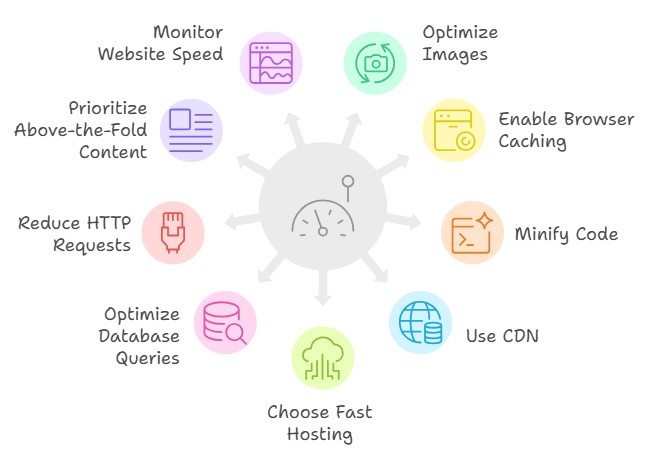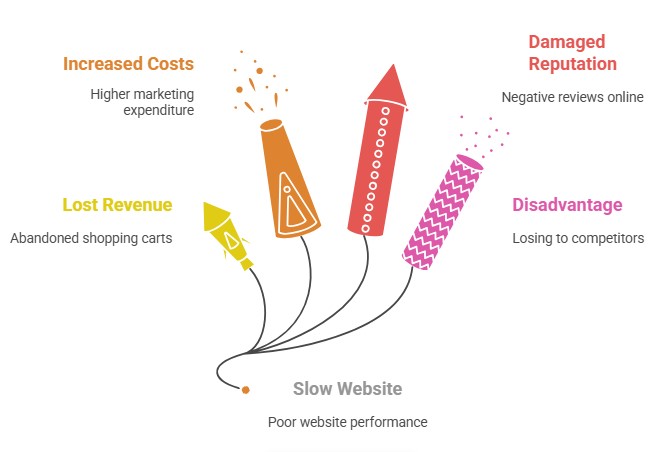Website speed and performance are critical factors for business success in today’s digital landscape. A slow-loading or poorly performing website can lead to frustrated users, high bounce rates, and ultimately, lost conversions. This document examines the substantial impact of website speed and performance on conversions, emphasizing why businesses should prioritize optimizing their online presence for speed and efficiency.
The Direct Link Between Speed and User Experience
User experience (UX) is paramount to online success. A fast website contributes directly to a positive UX, while a slow website creates a negative one. Here’s how speed impacts UX:

- First Impressions: A website’s loading time is often the first interaction a user has with a brand. A slow load time can create a negative first impression, signaling to the user that the website is unreliable or unprofessional.
- Engagement: Users are more likely to engage with a website that loads quickly. They’ll browse more pages, spend more time exploring content, and be more receptive to calls to action.
- Mobile Experience: With the majority of internet users accessing websites on mobile devices, speed is even more critical. Mobile users expect fast loading times, and a slow mobile website can be particularly frustrating.
- Accessibility: A well-optimized website is more accessible to users with slower internet connections or older devices.
The Impact on Conversions
The ultimate goal of many websites is to drive conversions, whether that’s making a sale, generating a lead, or encouraging a sign-up. Website speed and performance have a direct impact on conversion rates:
- Reduced Bounce Rates: A slow-loading website can lead to high bounce rates, meaning users leave the site before interacting with it. Optimizing for speed reduces bounce rates, keeping users engaged and increasing the likelihood of conversion.
- Increased Time on Site: Faster websites encourage users to spend more time browsing and exploring content. The longer a user stays on a site, the more opportunities there are to convert them.
- Improved Search Engine Rankings: Search engines like Google consider website speed as a ranking factor. Faster websites tend to rank higher in search results, leading to increased organic traffic and potential conversions.
- Enhanced Mobile Conversions: Mobile users are susceptible to website speed. Optimizing for mobile speed can significantly improve mobile conversion rates.
- Positive Brand Perception: A fast and reliable website enhances brand perception, signaling to users that the business is professional and trustworthy. This can lead to increased customer loyalty and repeat business.
Key Strategies for Optimizing Website Speed and Performance
Several strategies can be implemented to optimize website speed and performance:

- Optimize Images: Compress images to reduce file size without sacrificing quality. Use appropriate image formats (e.g., JPEG for photos, PNG for graphics).
- Enable Browser Caching: Browser caching allows users’ browsers to store static files (e.g., images, CSS, JavaScript) locally, reducing the need to download them on subsequent visits.
- Minify CSS, JavaScript, and HTML: Minification removes unnecessary characters from code, reducing file size and improving loading times.
- Use a Content Delivery Network (CDN): A CDN distributes website content across multiple servers, allowing users to access content from the server closest to their location.
- Choose a Fast Web Hosting Provider: A reliable web hosting provider with fast servers is essential for website speed and performance.
- Optimize Database Queries: Efficient database queries can significantly improve website loading times.
- Reduce HTTP Requests: Minimize the number of HTTP requests required to load a page by combining files, using CSS sprites, and optimizing images.
- Leverage Browser Caching: Configure your server to properly leverage browser caching, allowing browsers to store static assets locally.
- Prioritize Above-the-Fold Content: Ensure that the content visible without scrolling loads quickly, providing users with an immediate positive experience.
- Regularly Monitor and Test Website Speed: Use tools like Google PageSpeed Insights, GTmetrix, and WebPageTest to monitor website speed and identify areas for improvement.
The Cost of Ignoring Website Speed
Ignoring website speed and performance can have significant financial consequences:

- Lost Revenue: Slow websites can lead to abandoned shopping carts, missed leads, and ultimately, lost revenue.
- Increased Customer Acquisition Costs: If a website is slow, it may require more marketing spend to acquire the same number of customers.
- Damage to Brand Reputation: A slow and unreliable website can damage brand reputation, leading to negative reviews and lost customer trust.
- Competitive Disadvantage: In today’s competitive online landscape, a slow website can put a business at a significant disadvantage compared to competitors with faster websites.
